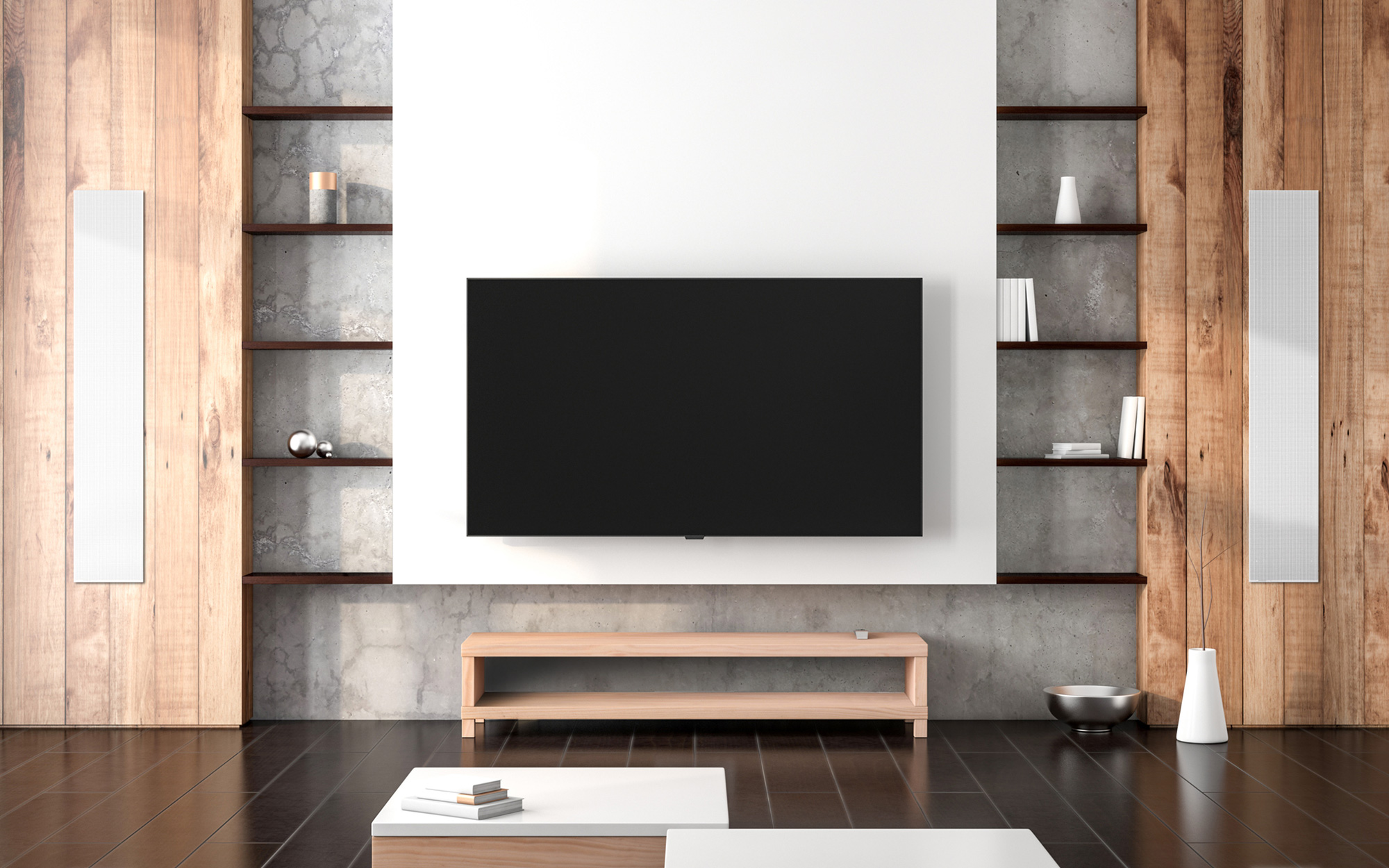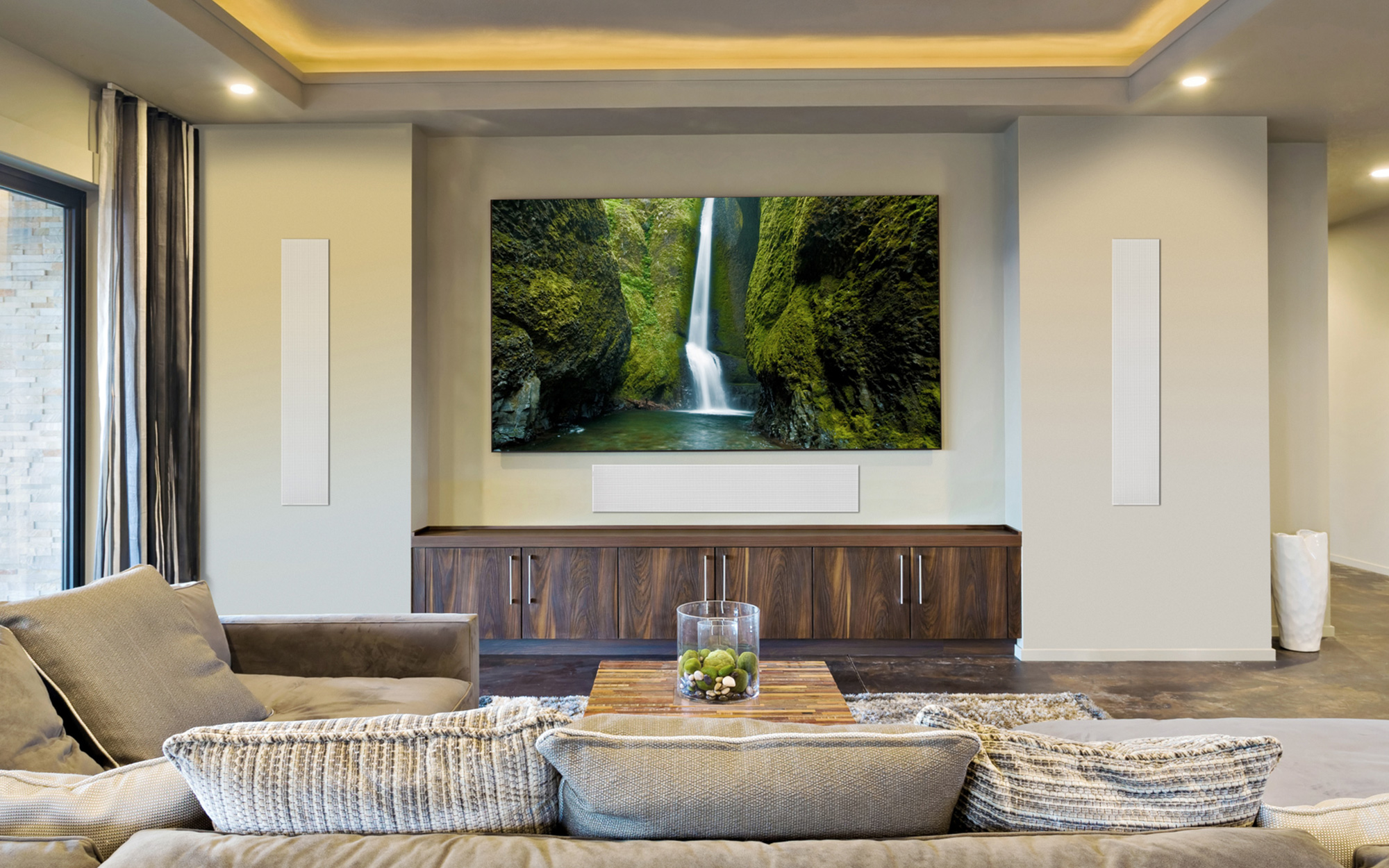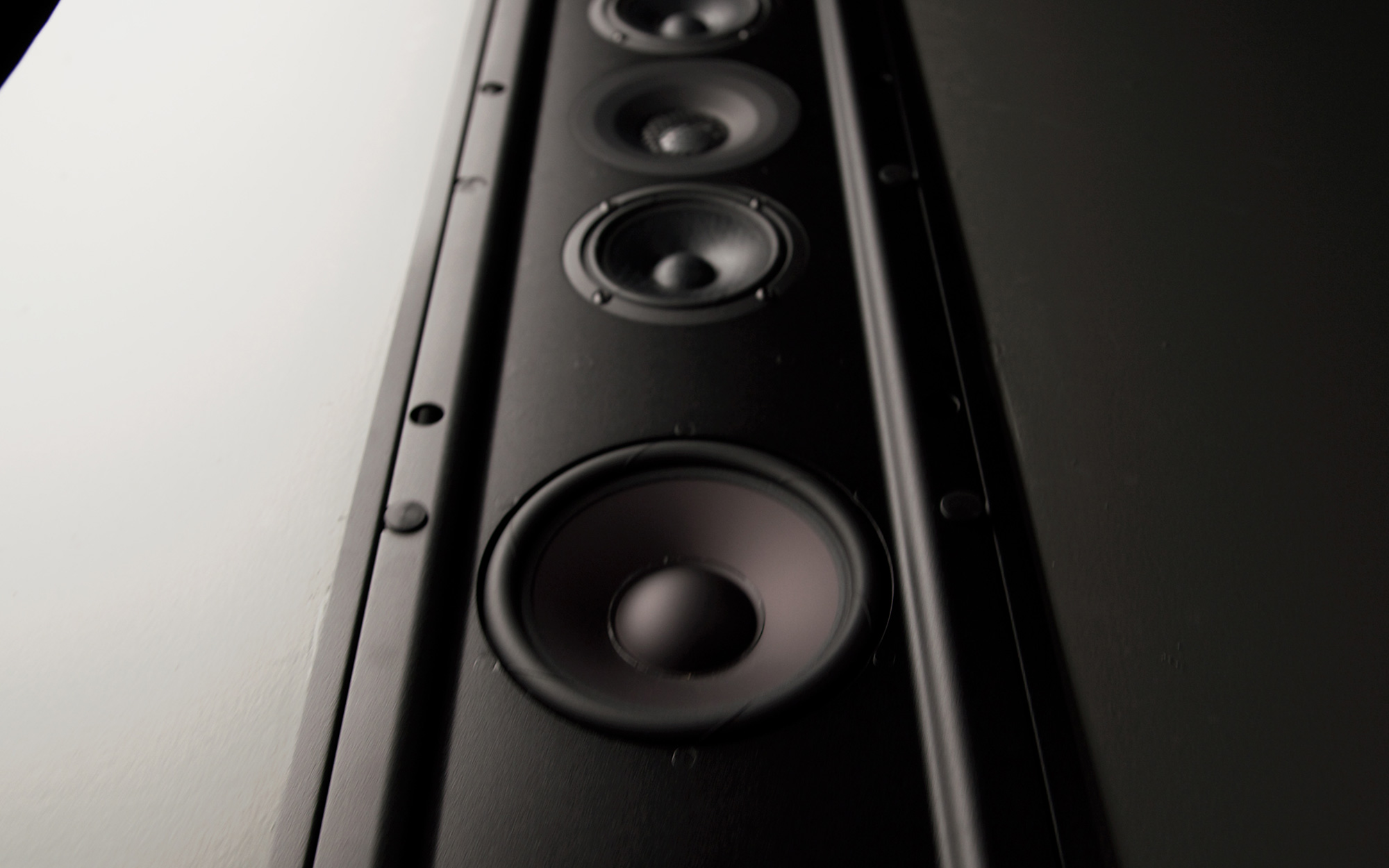
Reference Series In-Wall
Meridian customers - create an account so you can register your product(s) for your extended warranty.
Dealers, integrators, and installers - create an account to request access to Dealer Resources and/or apply to become a Meridian dealer.

Reference Series In-Wall
The class-leading DSP750 is Meridian’s highest performing architectural loudspeaker.
Engineered using Meridian’s, core principles of acoustic design, the DSP750 delivers high-resolution audio that is perfect for architectural installations and dedicated home theatres.
Featuring all-new drive-units, including a beryllium tweeter, the DSP750 produces a natural and lifelike sound with high fidelity and perfect tonal balance. Its high dynamic range, incredibly low distortion, and outstanding signal-to-noise ratio combine to provide full-range audio with exceptional headroom and low listener-fatigue.
Find a distributorReference Series In-Wall
DSP750
With a host of exclusive Meridian technologies on-board, the DSP750 resets the standard of architectural loudspeaker performance. Ultra-shallow (100mm deep) design provides full DSP loudspeaker performance, while the rough-in box and frame system allows for easy installation and precise positioning. Grill can be painted to match décor.
Meridian Bespoke Signal Mapping utilises digital signal processing to apply tailored crossover filters that are designed specifically for each configuration of drive units within a loudspeaker.
Meridian E3 Bass uses specifically designed filters to expand, extend and enhance the low-frequency response of the loudspeaker.
Image Elevation psychoacoustically raises the sound image to the centre of a screen – where the listener would expect to hear it from.

FFA (Full Frequency Alignment) is a combination of digital filters and delays to correct the group-delay of a loudspeakers. It ensures that all frequencies reach the listener’s ear at the same time.
Meridian Pro-Active Bass protects the bass drivers from over-excursion, ensuring maximum bass output without damaging the drive units.
Meridian Pro-Active Thermal monitors the audio being sent to the mid-range drivers and tweeters and limits the overall volume of the loudspeaker if there is a risk of the drive units getting too hot.
True Time is Meridian's proprietary Apodising Filter that avoids pre-ringing and cleans up the effects of early filters, converting pre-echo to post-echo.
Meridian True Link is an encryption method for transferring high-definition digital audio over SPDIF connections. It allows secure movement of digital audio whilst ensuring that the SPDIF clock signal can be transmitted with minimum degradation.
Meridian's HPA (High Powered Array) processing technology minimises destructive interference between the multiple loudspeakers when used in an array configuration.
Architectural Reference Range
Our Architectural loudspeakers incorporate resolution enhancing technologies for the ultimate listening experience in a large range of installation applications.The DSP750 is joined by the DSP730 in the Reference series, with both loudspeakers delivering Hi-Res audio and the very best in dynamics and clarity.
Here you will find a quick overview of the product highlights and features
Here you will find installation information and operating instructions.
Here you will find a summary of the complete range of Meridian products in one document.

AUDIO INPUTS
Meridian SpeakerLink connector (RJ45) accepting 32kHz to 96kHz sampling rates at up to 24-bit
AUDIO OUTPUTS
Meridian SpeakerLink connector (RJ45) delivering 32kHz to 96kHz sampling rates at up to 24-bit
PERFORMANCE
Peak SPL: 1m - 120dB
Bass extension: 30Hz
AMPLIFIERS
Tweeter: 2 x Class-D amplifiers bridged for 100W into 8 Ohms
Mid-range drivers (each): 2 x Class-D amplifiers bridged for 100W into 8 Ohms
Bass drivers (each): 2 x Class-D amplifiers bridged for 100W into 8 Ohms
BASS DRIVERS
2 x 160mm long-throw design
MID-RANGE DRIVERS
2 x 100mm with woven polyproylene cones
TWEETER
Beryllium dome with diffraction expansion technology
FRONT PANEL CONTROLS
On/off rocker switch, Fuse holder, IR window
Rocker switch selects “Right”, “L + R”, “Left or Centre”
RS232 socket – 3.5mm minijack (long version – 18.6mm)
LED indicators show power status and configuration settings
DISPLAY
LED indicators to show power status and configuration settings
DIMENSIONS / WEIGHT
HEIGHT: 1230mm [48.5in] (Excludes frame and cable feed channel)
WIDTH: 203mm [8in]
DEPTH: 102mm [4in]
WEIGHT: 16 kg [35 lbs]
GRILLE DIMENSIONS
HEIGHT: 1251.3mm [49.25in]
WIDTH: 222.5mm [8.73in]
DEPTH: 4mm [0.16in]
POWER
IEC mains cable included with loudspeaker for connection to rough-in box



When the loudspeaker is in Standby mode a blue LED will show on the front of the loudspeaker.
The DSP750 comes out of Standby mode when it receives an appropriate communication signal from another Meridian product. This signal is received on the SpeakerLink input socket of the loudspeaker and is produced when the rest of the system is brought out of Standby. When this happens, the front panel LED will change from blue to white. If the DSP750 has its IR receiver switched on, it can also be brought out of Standby by using a source command sent from a Meridian System Remote.
This can be done in two ways:
• IR reception can be activated and deactivated using a Meridian system remote control. Instructions for how to do this can be found in the product’s User Guide.
• There are RS232 commands to activate and deactivate IR reception. Details can be found in the product’s User-Guide.
Each loudspeaker uses a maximum of 500W.
The loudspeaker on the left (when viewed from the listening position) should be set to 'Left or Centre' and the loudspeaker on the right should be set to 'Right'. The switch is required because the SpeakerLink lead feeding the loudspeaker carries both left and right audio channels. The switch 'tells' the loudspeaker which channel to pick up from the lead. This is true even when each loudspeaker is fed with a dedicated SpeakerLink lead.
Loudspeakers in use as main-left, side-left, rear-left or centre channels should be set as “Left or Centre”. Set the switch to “Right” for loudspeakers in use as main-right, side-right or rear-right channels.
This sets the loudspeaker to play a balanced mix of left and right audio, allowing a single loudspeaker to reproduce all the audio present in a stereo recording. It provides a useful option for systems using multiple loudspeakers where the listening area does not have clearly defined left and right loudspeaker positions. This also allows a single DSP750 to be used below a TV screen.
The pair of loudspeakers can be connected in a 'daisy-chain' arrangement. The input of one loudspeaker should be connected to the SpeakerLink output on the controller-product. The output of this loudspeaker is then connected to the input socket on the other loudspeaker.
Yes. If cabling arrangements or other physical considerations preclude star-wiring, daisy-chaining can be used for a pair of DSP750 loudspeakers. This applies as long as the two loudspeakers are a 'pair' as defined in a Meridian system, i.e. they are the left and right main channels, the rear-left and rear-right channels or the side-left and side right channels.
If the DSP750s are among the largest loudspeakers in the system, they can be set as 'Large'. If they are among the smaller loudspeakers in the system, then it may be advantageous to set them as 'Small'. This will divert low bass (as defined by the crossover setting in configuration) away from the loudspeakers in question and send it to the subwoofer and/or the 'Large' loudspeakers in the system. The exact route of the bass is determined by several factors within configuration. Bear in mind that in a system with no subwoofer, the main (front) loudspeakers are forced to be 'Large', regardless of their physical size. If all the other loudspeakers are defined as 'Small', the main loudspeakers will be asked to play back all the bass for the system. In such cases, defining some or all of the DSP750s as 'Large' could help spread the bass load across the system. This could result in improved bass reproduction at low to mid volume levels and, as the DSP750s feature Meridian's Pro-active Bass technology, even at high volumes the risk of 'bottoming out' a bass drive is minimal.
Bass output can be increased, but it may require some configuration. Refer to the support documentation relating to Meridian subwoofers for further information.
This can be done if a Meridian 218 Zone Controller is also added to the system. The 218 has on-board DSP which can derive dedicated feeds for the subwoofer as well as the main left and right channels. The 218 features gain and filter controls to allow the subwoofer to be sonically integrated with the main loudspeakers.
Yes. There will be no need to use an external PSU with the Distributor 1.
Yes. The DSP750 can be used either vertically or horizontally as a centre-channel loudspeaker.
Each of the five drive-units is fed by a pair of Class-D amplifiers bridged for 100W into 8 Ohms.
The loudspeaker can be installed into the RF600 rough-in-box, or the more basic MB600 mounting bracket.
Yes. By default, the loudspeaker has FFA enabled and the internal switch for FFA is set to change only if the loudspeaker receives the relevant command on its SpeakerLink input. This behaviour can be changed by adjusting the internal setting for FFA using the relevant RS232 command. This allows the loudspeaker to have FFA switched on or off irrespective of any command received over SpeakerLink.
Image Elevation allows the image from a centre-channel loudspeaker to be raised to be in line with the main left and right loudspeakers. In Meridian surround-sound installations where the DSP750 is mounted horizontally below a screen, Image Elevation can be adjusted to give the impression that centre-channel sound is coming from the screen rather than below it. The setting is selectable between a minimum, a medium or a maximum elevation effect. It can be adjusted from the menu system of any Meridian Surround Controller equipped with SpeakerLink outputs. The option also exists to set Image Elevation on the loudspeaker via RS232. This RS232 setting is non-volatile, so if preferred it can be selected and set to a fixed level as part of the installation process